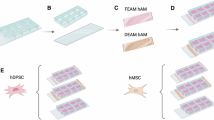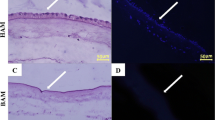Abstract
Developing effective stem cell-based therapies requires the design of complex in vitro culture systems for accurate representation of the physiological stem cell niche. Human amniotic membrane (hAM) has been successfully used in clinical grafting applications due to its unique biological and regenerative properties. Decellularized hAM (d-hAM) has been previously applied to the culture of human bone marrow mesenchymal stem cells (hMSCs), promoting their expansion and differentiation into adipogenic and osteogenic lineages. In the present study, hAM was decellularized by NaOH-treatment, to provide the three-dimensional (3D) bioscaffold for culturing hMSCs. The ultrastructural differences between intact hAM and decellularized hAM were characterized using the transmission electron microscope (TEM), as well as the 3D interaction between d-hAM and hMSCs cultured on the membrane. TEM examination of the intact hAM showed many microvilli on the epithelial layer cells, active Golgi apparatus, smooth endolplasmic reticulum and the characteristic pinocytic vesicles. The epithelial layer with its structures was absent in the d-hAM. However, no observable difference was detected in the ultrastructural characteristics of the compact stromal layer of d-hAM compared to intact hAM. Both contained bundles of extra cellular matrix (ECM) proteins, and scattered elastic fibres. Cultured human mesenchymal stem cells (hMSCs) examined by TEM appeared oval to spherical in shape and had a rough and non-uniform surface with distinct protrusions or irregular fillopodia. Their diameter ranged from 20.49 to 21.6 µm. Most of the cellular organelles were also noticed. SEM examination of the prepared samples revealed unique 3D interaction between the hMSC and d-hAM, where the latter seems to envelop the segments of the hMSCs lying on the surrounding membrane. This study shows that the decellularization process affected the epithelial layer only of hAM and had no effect on altering the presence of ECM components present in the stromal layer of the d-hAM. The interaction between hMSCs and d-hAM maybe mediated by hAM components other than human amniotic epithelial cells, such as ECM components or MSCs present in the deeper spongy layer of the membrane or/and the adhesive components of the basement membrane of the removed epithelial layer.










Similar content being viewed by others
References
Ab Hamid SS et al (2014) Scanning electron microscopic assessment on surface morphology of preserved human amniotic membrane after gamma sterilisation. Cell Tissue Bank 15(1):15–24
Al-Yahya ARA, Makhlouf MM (2013) Characterization of the human amniotic membrane: histological, immunohistochemical and ultrastructural studies. Life Sci J 4:10
Aplin JD, Campbell S, Allen TD (1985) The extracellular matrix of human amniotic epithelium: ultrastructure, composition and deposition. J Cell Sci 79:119–136
Brown EJ, Goodwin JL (1988) Fibronectin receptors of phagocytes. Characterization of the Arg-Gly-Asp binding proteins of human monocytes and polymorphonuclear leukocytes. J Exp Med 167(3):777–793
Buhimschi IA et al (2004) The novel antimicrobial peptide beta3-defensin is produced by the amnion: a possible role of the fetal membranes in innate immunity of the amniotic cavity. Am J Obstet Gynecol 191(5):1678–1687
Chen C et al (2018) Transplantation of amniotic scaffold-seeded mesenchymal stem cells and/or endothelial progenitor cells from bone marrow to efficiently repair 3-cm circumferential urethral defect in model dogs. Tissue Eng A 24(1–2):47–56
Clark RA (1993) Biology of dermal wound repair. Dermatol Clin 11(4):647–666
Clark RA et al (1988) Cryptic chemotactic activity of fibronectin for human monocytes resides in the 120-kDa fibroblastic cell-binding fragment. J Biol Chem 263(24):12115–12123
Cooper LJ et al (2005) An investigation into the composition of amniotic membrane used for ocular surface reconstruction. Cornea 24(6):722–729
Du Y et al (2016) The angiogenic variation of skeletal site-specific human BMSCs from same alveolar cleft patients: a comparative study. J Mol Histol 47(2):153–168
Eggenhofer E et al (2012) Mesenchymal stem cells are short-lived and do not migrate beyond the lungs after intravenous infusion. Front Immunol 3:297
El-Badawy A et al (2017) Cancer cell-soluble factors reprogram mesenchymal stromal cells to slow cycling, chemoresistant cells with a more stem-like state. Stem Cell Res Ther 8(1):254
Felix H et al (1982) Interactions of tumor cells with human amnion membrane: a model for studying tumor invasion in vitro. Scan Electron Microsc 1982(Pt 2):741–749
Gholipourmalekabadi M et al (2015) Development of a cost-effective and simple protocol for decellularization and preservation of human amniotic membrane as a soft tissue replacement and delivery system for bone marrow stromal cells. Adv Healthc Mater 4(6):918–926
Gholipourmalekabadi M et al (2017) Silk fibroin/amniotic membrane 3D bi-layered artificial skin. Biomed Mater. https://doi.org/10.1088/1748-605X/aa999b
Guilak F et al (2009) Control of stem cell fate by physical interactions with the extracellular matrix. Cell Stem Cell 5(1):17–26
Hao Y et al (2000) Identification of antiangiogenic and antiinflammatory proteins in human amniotic membrane. Cornea 19(3):348–352
Hu J, Cai Z, Zhou Z (2009) Progress in studies on the characteristics of human amnion mesenchymal cells. Prog Nat Sci 19(9):1047–1052
Janicki P, Schmidmaier G (2011) What should be the characteristics of the ideal bone graft substitute? Combining scaffolds with growth factors and/or stem cells. Injury 42(Suppl 2):S77–S81
Jiang F et al (2015) Amniotic mesenchymal stem cells can enhance angiogenic capacity via mmps in vitro and in vivo. Biomed Res Int 2015:324014
Khalil S et al (2016) A cost-effective method to assemble biomimetic 3D cell culture platforms. PLoS ONE 11(12):e0167116
Kim JS et al (2000) Amniotic membrane patching promotes healing and inhibits proteinase activity on wound healing following acute corneal alkali burn. Exp Eye Res 70(3):329–337
King AE et al (2007) Expression of natural antimicrobials by human placenta and fetal membranes. Placenta 28(2–3):161–169
Lawler PR, Lawler J (2012) Molecular basis for the regulation of angiogenesis by thrombospondin-1 and -2. Cold Spring Harb Perspect Med 2(5):a006627
Lee SB et al (2000) Suppression of TGF-beta signaling in both normal conjunctival fibroblasts and pterygial body fibroblasts by amniotic membrane. Curr Eye Res 20(4):325–334
Lim LS et al (2009) Effect of dispase denudation on amniotic membrane. Mol Vis 15:1962–1970
Lin F et al (2005) Three-dimensional migration of human adult dermal fibroblasts from collagen lattices into fibrin/fibronectin gels requires syndecan-4 proteoglycan. J Invest Dermatol 124(5):906–913
Matsubara, Sato BK (2000) Pathology of the human placenta. Springer, New York
Miko M et al (2015) Ultrastructural analysis of different human mesenchymal stem cells after in vitro expansion: a technical review. Eur J Histochem 59(4):2528
Motamed M et al (2017) Tissue engineered human amniotic membrane application in mouse ovarian follicular culture. Ann Biomed Eng 45(7):1664–1675
Niknejad H et al (2008) Properties of the amniotic membrane for potential use in tissue engineering. Eur Cell Mater 15:88–99
Nubile M et al (2008) Amniotic membrane transplantation for the management of corneal epithelial defects: an in vivo confocal microscopic study. Br J Ophthalmol 92(1):54–60
Pappa KI, Anagnou NP (2009) Novel sources of fetal stem cells: where do they fit on the developmental continuum? Regen Med 4(3):423–433
Parolini O et al (2008) Concise review: isolation and characterization of cells from human term placenta: outcome of the first international workshop on placenta derived stem cells. Stem Cells 26(2):300–311
Pasquinelli G et al (2007) Ultrastructural characteristics of human mesenchymal stromal (stem) cells derived from bone marrow and term placenta. Ultrastruct Pathol 31(1):23–31
Plaks V, Kong N, Werb Z (2015) The cancer stem cell niche: how essential is the niche in regulating stemness of tumor cells? Cell Stem Cell 16(3):225–238
Ravi M et al (2015) 3D cell culture systems: advantages and applications. J Cell Physiol 230(1):16–26
Saghizadeh M et al (2013) A simple alkaline method for decellularizing human amniotic membrane for cell culture. PLoS ONE 8(11):e79632
Scadden DT (2014) Nice neighborhood: emerging concepts of the stem cell niche. Cell 157(1):41–50
Schleich A et al (1981) Interaction of human carcinoma cells with an epithelial layer and the underlying basement membrane. A new model. Arch Geschwulstforsch 51(1):40–44
Schultz GS, Wysocki A (2009) Interactions between extracellular matrix and growth factors in wound healing. Wound Repair Regen 17(2):153–162
Shaw RJ et al (1990) Adherence-dependent increase in human monocyte PDGF(B) mRNA is associated with increases in c-fos, c-jun, and EGR2 mRNA. J Cell Biol 111(5 Pt 1):2139–2148
Shimazaki J, Yang HY, Tsubota K (1997) Amniotic membrane transplantation for ocular surface reconstruction in patients with chemical and thermal burns. Ophthalmology 104(12):2068–2076
Singh RK et al (1996) Tumor cell invasion of basement membrane in vitro is regulated by amino acids. Cancer Invest 14(1):6–18
Solomon A et al (2001) Suppression of interleukin 1alpha and interleukin 1beta in human limbal epithelial cells cultured on the amniotic membrane stromal matrix. Br J Ophthalmol 85(4):444–449
Soncini M et al (2007) Isolation and characterization of mesenchymal cells from human fetal membranes. J Tissue Eng Regen Med 1(4):296–305
Talmi YP et al (1991) Antibacterial properties of human amniotic membranes. Placenta 12(3):285–288
Toda A et al (2007) The potential of amniotic membrane/amnion-derived cells for regeneration of various tissues. J Pharmacol Sci 105(3):215–228
Tseng SC, Li DQ, Ma X (1999) Suppression of transforming growth factor-beta isoforms, TGF-beta receptor type II, and myofibroblast differentiation in cultured human corneal and limbal fibroblasts by amniotic membrane matrix. J Cell Physiol 179(3):325–335
Tsuboi R, Rifkin DB (1990) Bimodal relationship between invasion of the amniotic membrane and plasminogen activator activity. Int J Cancer 46(1):56–60
Walasek MA, van Os R, de Haan G (2012) Hematopoietic stem cell expansion: challenges and opportunities. Ann N Y Acad Sci 1266:138–150
Wells WJC (1946) Amniotic membrane for corneal grafting. Br Med J 2(4477):624–625
Westekemper H et al (2017) Clinical outcomes of amniotic membrane transplantation in the management of acute ocular chemical injury. Br J Ophthalmol 101(2):103–107
Acknowledgements
We thank the Electron Microscopy Unit of Theodor Bilharz Research Institute (TBRI), Giza, Egypt for using their Electron Microscopy imaging facility. We thank the Sheikh Zayed Hospital team for facilitating the process of obtaining the amniotic membrane samples and the consent of patients. This work was supported by Science and Technology Development Fund Grant 5300.
Author information
Authors and Affiliations
Corresponding author
Rights and permissions
About this article
Cite this article
Salah, R.A., Mohamed, I.K. & El-Badri, N. Development of decellularized amniotic membrane as a bioscaffold for bone marrow-derived mesenchymal stem cells: ultrastructural study. J Mol Hist 49, 289–301 (2018). https://doi.org/10.1007/s10735-018-9768-1
Received:
Accepted:
Published:
Issue Date:
DOI: https://doi.org/10.1007/s10735-018-9768-1




